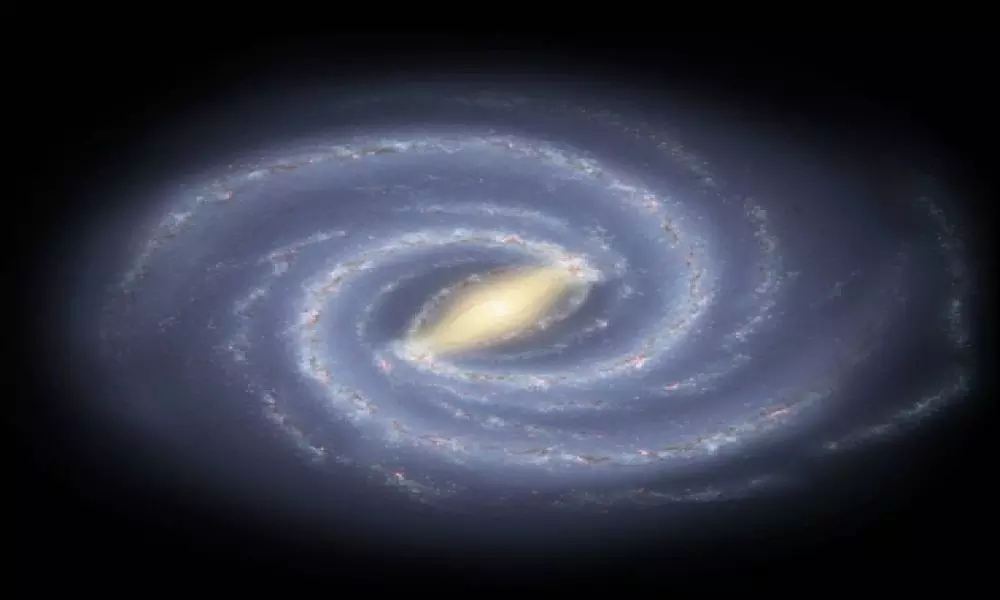Live
- Rahul to address ‘Samvidhan Bachao’ rally in city
- Swiggy’s SNACC to deliver coffee in 15 minutes
- Maha Kumbh Mela: Special arrangements to handle passengers’ influx at rly station
- Kumbh Sahayak App, a digital companion for millions of devotees
- Dr. Veerappa Moily's New Book to be Unveiled in Moodbidri
- Congress begins exercise to pick candidates for MLC polls
- Ensure uninterrupted power supply in summer season: CM
- Public Participation Key to Strengthening Democracy-Annamalai
- MLA Anirudh Reddy gets threat letter from Maoist
- "Awareness Program on Road Safety for Auto Drivers Held in Aija Town".
Just In
Recycled gas from stars surrounds Milky Way, shows mini satellite


Recycled gas from stars surrounds Milky Way, shows mini satellite
Observations made by a small spacecraft called HaloSat have shown that the Milky Way galaxy is surrounded by a clumpy halo of hot gases that is continually being supplied with material ejected by birthing or dying stars.
Observations made by a small spacecraft called HaloSat have shown that the Milky Way galaxy is surrounded by a clumpy halo of hot gases that is continually being supplied with material ejected by birthing or dying stars. A halo is a large region filled with hot gas that surrounds a galaxy, also known as a "circumgalactic medium."
The heated gaseous halo around the Milky Way was the incubator for the Milky Way's formation some 13 billion years ago and could help solve a longstanding puzzle about where the missing matter of the universe might reside.
In the new NASA-funded study published in the journal Nature Astronomy, the researchers concluded the circumgalactic medium has a disk-like geometry, based on the intensity of X-ray emissions coming from it.
"The X-ray emissions are stronger above the parts of the Milky Way where star formation is more vigorous," said Philip Kaaret, Professor at the University of Iowa and corresponding author on the study.
"That suggests the circumgalactic medium is related to star formation, and it is likely we are seeing gas that previously fell into the Milky Way, made stars, and now is being recycled into the circumgalactic medium."
Every galaxy has a circumgalactic medium, and these regions are crucial to understanding not only how galaxies formed and evolved but also how the universe progressed from a kernel of helium and hydrogen to a cosmological expanse teeming with stars, planets, comets, and all other sorts of celestial constituents.
HaloSat searches for baryonic matter -- that is, the same kind of particles that compose the visible world -- believed to be missing since the universe's birth.
The satellite has been observing the Milky Way's circumgalactic medium for evidence that the missing baryonic matter may reside there.
Baryonic matter is distinct from dark matter, which is invisible and does not interact through any force except gravity. Scientists can only account for about two-thirds of the baryonic matter that should be present in the universe.
To look for the missing matter, Kaaret and his team wanted to get a better handle on the circumgalactic medium's configuration.
More specifically, the researchers wanted to find out how big the circumgalactic medium really is.
If it is a huge, extended halo that is many times the size of our galaxy, it could house enough material to solve the missing baryonic question.
But if the circumgalactic medium is mostly comprised of recycled material, it would be a relatively thin, puffy layer of gas and an unlikely host of the missing baryonic matter.
"What we've done is definitely show that there's a high-density part of the circumgalactic medium that's bright in X-rays," Kaaret says.
"But there still could be a really big, extended halo that is just dim in X-rays. And it might be harder to see that dim, extended halo because there's this bright emission disk in the way.
"So it turns out with HaloSat alone, we really can't say whether or not there really is this extended halo around the Milky Way," Kaaret said.
HaloSat is a NASA CubeSat mission led by the University of Iowa.

© 2025 Hyderabad Media House Limited/The Hans India. All rights reserved. Powered by hocalwire.com






